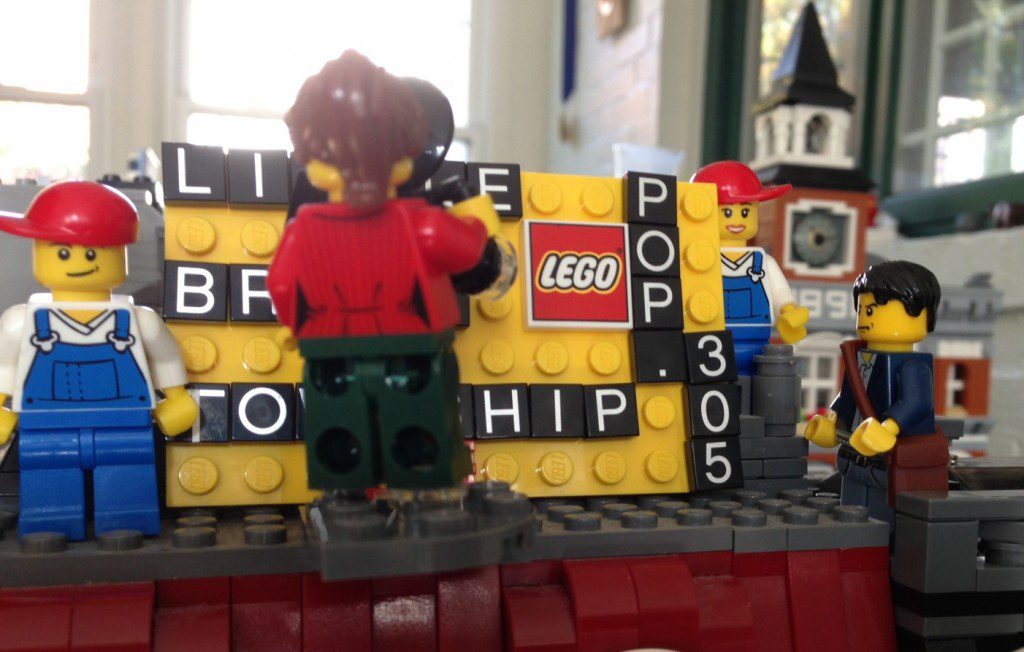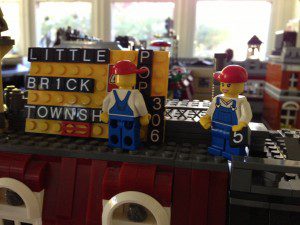Nonconforming Kids: Some Thoughts for National Bullying Prevention Month
Although I’m devoting most of my October posts to what my Lego town can show about writing, October is also National Bullying Prevention Month. As a survivor of relentless bullying in elementary, middle, and high school, I feel compelled to do my part to make sure no child or teenager goes through what I went through at that age.

Karlijn’s behavior with Patricio and Giovanni caused the town to turn against her and her family to send her away. The “scarlet letter” still holds true in Little Brick Township.
At the beginning of this month, I watched the documentary “Valentine Street” on HBO. The film explores a deadly shooting on February 12, 2008 at a middle school in Oxnard, California. Fourteen-year-old Brandon McInerny shot classmate Lawrence (Larry) King in a computer lab because Larry had embarrassed Brandon in front of his friends by asking Brandon to be his valentine. Larry, who was 15 and living in a shelter for homeless teens, identified as male to female transgender and often wore makeup and earrings along with his school uniform. He was also biracial. Brandon, who had an abusive father and both parents with drug and alcohol addictions, had recently contacted a white supremacist group.
What struck me most about the documentary was the attitude of the adults at the school. While both boys came from troubled backgrounds, Brandon was seen as a “good kid,” while Larry had learning disabilities and had been in and out of trouble, mostly because of his nonconforming gender identity. He would ask teachers to call him by a girl’s name, and most refused and punished him for being disruptive. One teacher, however, sought to be an ally to him and to the other LGBTQ students at the school. After the shooting, that teacher lost her position and went, in her words, from “a $55 an hour job to a $9 an hour job” at Starbuck’s. The other teachers — the ones who punished and ostracized Larry, who thought he was the one who needed to change because being gay or trans was a “sin” — continue to teach at the school. And in the district, LGBTQ kids continue to be bullied.
The LGBTQ kids in the documentary — the ones who were Larry’s only friends — spoke about how the term “gay” is used as an all-round epithet. Their words made me think of another word that was commonly used in that way, and often still is — “retarded.” I got called “retarded” a lot when I was growing up. I also had trouble fitting in. Teachers often found me difficult or disruptive, and I had a hard time finding kids my age who would be my friends.
To combat bullying effectively, we have to acknowledge the fact that kids who constantly find themselves the target of bullies may also be the hardest kids to like — but it doesn’t matter. Adults have to be the adults here. We have to confront our own prejudices, whether they be preconceptions about what developmentally disabled kids are capable of accomplishing, ideological beliefs about sexual orientation and gender identity, or ideas of how “weird” kids should behave and fit in. If kids have made choices related to drinking, drugs, or sexual relationships that get them labeled and shunned, harassed, or cyberbullied, we have to understand that they are kids — still works in progress — and we as adults must not turn our backs on them. All the anti-bullying posters and speeches do no good at all if we adults show that we don’t care as much about those children and teens who do not conform to the mainstream or who make what appear to be bad choices. There are many ways that adults overtly and subtly enable the bullying of nonconforming kids — the kids that almost no one seems to like — and awareness is the first step to ending this vicious pattern.

The townspeople thought Patricio would be happiest of all to see Karlijn go, but he knows bullying when he sees it.
As you see from the photos, this is a lesson the denizens of Little Brick Township need to learn as well.








Lyn, I totally agree. adults and particularly those in educational settings that are supposed to be modeling positive behaviors themselves are often unaware that they are sending bullying signals, subtle or not. Perhaps awareness training is in order for any professional working with kids of all ages so that their destructive signals will stop. Just today as I was entering a supermarket a middle aged man had just left. He looked disheveled, and dragged one of his legs behind as he walked. Another thirtyish younger man made a comment and gesture, and another older woman heard. She told the young man that someday he might find himself in the same position, and that he shouldn’t have made the remark. The young man – who looked totally shocked-kept repeating he had no idea what she was talking about. Sadly, he probably didn’t.
Social networking has brought bullying and name calling to new heights. Some kind of training is in order. Individuals have no idea theat not only are they greatly hurting someone, but their families suffer as well, lifelong pain, either because of loss due to suicide or by totally destroying someone’s confidence for life.
Thank you for your comments, Janis. Unfortunately, social media not only facilitate the bullying of young people by their peers, to the point that too many have been driven to suicide, but also “age up” bullying because of the anonymity of the internet and the way that some social media, combined with celebrity culture, replicate the social hierarchies of middle and high school.
Lyn, I want to shout your post from the rooftops. Yes, adults are absolutely involved in and often facilitate the bullying. I’m not pleased with the anti-bullying campaigns I’m seeing people spend so much time and money on, as I think they’re misguided and misdirected. To whom does a student turn when the bully is the teacher? Is the principal really going to hold a teacher to a zero tolerance policy when the victim is a difficult to handle student? Everyone knows we are supposed to be nice to each other, so posters reminding us to be nice are a waste of time and money.
I have often felt that a major focus of the anti-bullying movement should be victim-focused. If we want at-risk bullied kids to stop tragically killing themselves, we need to be offering THOSE kids counseling and support. I honestly don’t think we can stop bullying. People will always find a way to bully, regardless of any zero tolerance rule or commercials telling them how mean they are. But supporting the victims is of utmost importance, especially as you so astutely point out, the victims who are unpopular and difficult to love. Thanks for speaking out on this with your unique perspective.
Thank you for your insights, Shelby. The kids who are targets of bullies year after year — as opposed to those who experience occasional and transient bullying — generally don’t have allies among the adults in the school. The general consensus seems to be that “something’s wrong” with the kid, and this is especially true of kids with mental health issues, untreated developmental or learning disabilities, and nonconforming gender identity or sexual orientation. You’re right that the focus needs to be on these kids because otherwise they’re all alone in a world that appears to hate them.
I think it’s important for nonconforming kids to have mentors, adults who genuinely do like them and perhaps have experienced the same things and know what it’s like to be constantly on the outside. I would never have survived my teenage years without two very caring teachers who functioned as my mentors — my ninth grade social studies teacher and my tenth grade English teacher. My social studies teacher did a superb job of walking the fine line of showing me how to live in the world while not telling me that I was the only one who had to change. I don’t think a mentoring relationship can work if all the mentor wants to do is make the child change who he or she is in order to fit in, because we’re who we were born to be and can only change and adapt up to a point.
I second–strongly–what Shelby says here. Such an important post, Lyn. Yes, bullying, unfortunately, will always exist. The focus should be on the victim. Kids out of step–even ‘positive problems’ like gifted children–aren’t always treated well by peers, teachers, or principals. They are problems. They take time. They demand a different response. So, thank you, Lyn, and thank you, Shelby for speaking out. These are words that need to be heard.
Thanks for this excellent post, Lyn. I’ve been researching issues teens face for a project, and bullying is definitely one of them. I didn’t know that October is National Bullying Prevention Month. What saddens me, as you mentioned here, is that kids continue to be bullied and receive next to no help. I agree with Shelby. The victims of bullying need to be offered support, rather than criticism.
Thank you for your comment, Linda, and good luck with your research project. Please let me know if you’d like any links or other information about bullying and bullying prevention, because I attended a workshop last May and still have the notes and references.